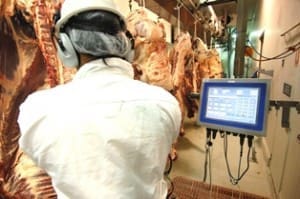THE accumulated effect of processors’ commercial decisions to reduce kills this year is clearly showing up in weekly Eastern States slaughter statistics.
There’s been a succession of announcements since the 2016 slaughter season opened, mostly recently advice from Teys Australia that it will retrenching staff and re-organising operations at the company’s Wagga plant to better align with cattle numbers. Similar calls have been made during February at other plants in Queensland, NSW and elsewhere operated by Teys, JBS and others.
 Speaking after JBS Australia yesterday announced cutbacks at its Bordertown (SA) lamb plant, for similar reasons, company director John Berry said JBS had made an “unfortunate but necessary decision.”
Speaking after JBS Australia yesterday announced cutbacks at its Bordertown (SA) lamb plant, for similar reasons, company director John Berry said JBS had made an “unfortunate but necessary decision.”
“We’re in a challenging situation around livestock supply across the country – both beef and lamb – and the industry has processed a high number of animals over the last couple of years,” Mr Berry said.
“Combined with that, we have challenging international market conditions with large volumes of low-priced animal protein around the world. Unfortunately Australia’s high-quality red meat is seeing some push-back from customers and markets alike in terms of the price that we’re looking to obtain,” he said.
Comments made by an economic analyst on ABC TV Landline on Sunday suggesting that processors are currently around breakeven on slaughter cattle appear well, well wide of the mark. Beef Central understands many Queensland processors this week are at or around minus $100 on grassfed steer fullset, and -$50-60 on cow profitability. Grainfeds are even worse, especially on 100-day cattle.
If processors were anywhere near breakeven on slaughter cattle this week, there would be clear signs of greater price competition occurring. Instead, all major processors have dug their heels in, leaving grid pricing virtually unchanged for a third or fourth consecutive week this week, to try to stem the bleeding. There is simply no appetite to try to kill more cattle at present, at current levels of profitability.
In essence processors are saying: “This is the price. If we can’t buy them for that, we don’t kill.”
Teys Australia’s flagship Beenleigh plant will kill just two days this week, as it did last week. A string of other large processing sites across Queensland, NSW and into Victoria are again scheduling reduced kills within shifts, skipped shifts or lost days.
It suggests last week’s Eastern States beef kill of 133,747 head may be representative for the next few months at least.
The number was back almost 13,000 head on the previous week, a decline of 9pc. Virtually all states were affected. Queensland’s kill fell 14pc to 58,160 head (28pc below this time last year). NSW fell 7pc to 33,036 head (-20pc year-on-year), while Victoria at 29,444 was little changed from the week before, but still -11pc on last year. South Australia was down 10pc to 8144 head (-16pc on yearly comparisons), while Tasmania at 4963 was unchanged.
Qld grids show rigor mortis
It’s as if a case of rigor mortis has set in on grid prices, with no appreciable change evident again across Queensland or northern NSW this week. Just to re-cap on our earlier weekly kill reports, best offers for four-tooth ox in SEQ export plants this week sits at 510c/kg, with heavy cows 455-465c. One northern NSW grid had non-HGP steer at 500c for 0-2 teeth and 490c for four-tooth; best cows 460c.
One set of SEQ grids has not changed since grid No. 1 went out at the start of the year. Many processors are tentative about forward pricing on grainfed cattle at the moment, still uneasy about where meat markets might trend.
In the saleyards system there are a few more cattle on offer this week, as there often is around mid-February.
That, plus the fact that some processors are now taking unpriced kill slots for March/April, perhaps reflects the fact that those producers fortunate enough to receive some early rain at the start of summer now have cattle approaching turnoff condition.
It may seem incongruous, but even in a year of extreme stock shortage like this, there are still likely to be small ‘spikes’ in supply in the year ahead.
“They won’t be as extreme as in the past, but we’d expect to see some growth in numbers when western and northern stock camps get back to work, for example,” one processor said.
“If it hasn’t rained by the end of March, we may see a short lift in slaughter cattle supply, among those producers who got decent early rain,” he said.
“It won’t be a wholesale avalanche of cattle, and should be a more measured supply, but it may allow processors to get back somewhere near a normal weekly kill for certain, if short, periods during the year.”
Meat trade outlook
The A$ remains stubbornly above US70c this week, trading this morning at US71.09c. That’s working against the competitiveness of Australian exports.
The US imported lean market for 90s is up a little again this week, but fattier trim remains unloved, a meat trade desk contact said.
While there has been only modest price rises evident for 90s this year in A$ terms, what’s interesting is the narrowing of the gap in price, in US$ terms, for imported 90s versus domestic US. The 40-50c gap that existed earlier (a discount on imported versus US domestic) has now all but disappeared.
That suggests not only shorter supply out of Australia, but also that the meat market thinks it cannot move much more.



HAVE YOUR SAY